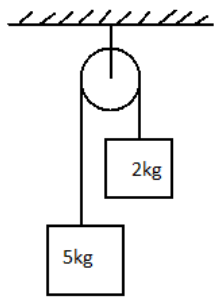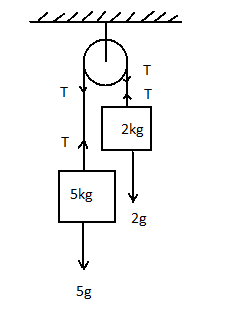Question
Question: In the arrangement shown, what is the normal reaction between the block \(A\) (mass \( = 5kg\) ) and...
In the arrangement shown, what is the normal reaction between the block A (mass =5kg ) and ground?

Solution
For a system to be in equilibrium, all the forces on each body have to balance each other otherwise the equilibrium would be destroyed. We can either draw free body diagrams for individual weights to mark all the forces on the diagram and balance it individually. Since the normal force is for block A therefore we only draw the normal force for A.
Formula used:
Fg=mg
Where Fg is the force due to gravity on the blocks due to which it gets pulled downward, m is the mass of the body and g is the acceleration due to gravity.
T is the tension in the string which keeps the string taut.
N is the normal on the block acting in the same direction as tension.
Complete step by step solution:

In the diagram,
T is the tension in the string, N is the normal on the block, m1=5kg , m2=2kg , and g=9.8ms−2 is the acceleration due to gravity.
To balance forces in string A ,
T+N=m1g
⇒T+N=5×9.8
⇒T+N=49N ...(1)
To balance forces in string B
T=m2g
⇒T=2×9.8
⇒T=19.6N ...(2)
Using ...(1) and ...(2)
⇒19.6+N=49N
⇒N=49−19.6
⇒N=29.4N
Therefore the normal force acting on block A is 29.4N.
Note: In systems such as this, it is important to mark all forces so as to avoid any silly mistakes. Write units with every data and if required, draw free body diagrams for individual bodies. The string and the pulley are considered massless since information is not provided to suggest otherwise. In ideal pulleys, the tension in both ends of the string is equal. Thus, it becomes simpler to balance tension and force of gravity along a normal reaction and find out either of the quantities.
